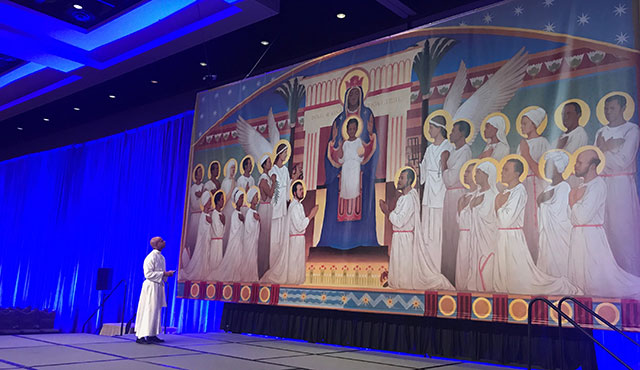It’s surprising how the term “conventional wisdom” eventually turns out to be an oxymoron. For example, it’s conventional wisdom that blacks from Africa who had been enslaved and shipped to America became Catholics only after arriving.
Wrong. Many had been Catholics in Africa long before they were shackled in chains.
It’s one of the many fascinating elements rooted in “Our Lady of Stono River,” a spectacular 30-foot-wide mural created for the National Black Catholic Congress. It beautifully depicts the Black Madonna and Child, surrounded by black individuals who played a prominent role in black Catholic history.
Formed in the 1880s, the National Black Catholic Congress (NBCC; nbccongress.org) represents African-American Roman Catholics and their member organizations, all working together to help evangelize African-Americans and assisting them in a variety of ways. NBCC members are committed to the freedom and growth of African-Americans as productive participants in the Church and society.
The idea for the mural came from Fr. Claude Williams, parochial vicar of St. John the Baptist Church in Costa Mesa, and a member of the Norbertine Order at St. Michael’s Abbey, in Silverado. He served as Liturgy Chairperson for last year’s Congress XII, the 12th in a series of key meetings attended by NBCC members, and he oversaw the project as the mural was being created.
“The idea of representing Mary as the Virgin of Stono River came after I learned about Cato’s Uprising by Dr. Diana Hayes, one of the influential scholars who argue that many of the blacks were Catholic in Africa, long before they were enslaved.”
One of the people depicted in the mural (pictured to the left of Mary and holding a rosary), Cato was the leader of the largest slave uprising in the British mainland colonies. It took place in September 1739 and began with an armed march south from the Stono River – hence the mural’s name. Like many of the enslaved people, Cato was originally from the Kingdom of Kongo, in West Central Africa. The leaders of Kongo had converted to Catholicism in 1491, followed by their people. Those who partook in the uprising were described as Catholic. Some scholars contend that taking action on the day after the Feast of Mary connected the Catholic past of those revolting with their present desires, that their Catholic faith had a significant impact on their decision to rebel.
Cato and the others in the mural form a diverse group of people – some blessed, some canonized, others neither. “We wanted to include black people from different parts of the world, people who spoke different languages and came from different states of life,” says Fr. Claude. “This was a very important element.”
Each figure tells a personal and important story, a story of black history, of Catholicism’s centuries-long influence on black lives, and, in turn, of blacks’ significant and ongoing influence on Catholicism by living a life in Christ.
“The twenty-one holy witnesses depicted along with the Virgin and Child are, except for Sts. Peter Claver and Katherine Drexel, black Catholics either from an African nation or somewhere in the Americas,” Fr. Claude says. “This sacred artwork communicates to the viewer a proud history of black intelligence, black artistry, and black Catholic faith across a broad continuum of millennia, continents and languages.”
One of the challenges in creating “Our Lady of Stono River” was that it had to be mobile, since many NBCC events, like Congress XII, take place in such locales as hotels.
“We wanted to provide [the attendees] with a sacred space,” Fr. Claude says. “We needed something to create the right atmosphere, more than just curtains and a cross.”
“The piece can be rolled up and transported, very much like we would’ve transported tapestries four hundred years ago,” says Enzo Selvaggi, lead designer of Heritage Liturgical (heritageliturgical.com) and the project’s lead artist.
Selvaggi’s calling to his profession comes from more than an artistic eye and a steady hand. “I believe that confecting sacred art is to prepare an opportunity for the viewer to encounter God,” he says. “And that’s always your hope as a designer and an artist. So the challenge is always this: How as a designer can I do everything in my power to collaborate with the powerful reality of God’s ineffable and indescribable beauty, while at the same time avoid putting myself in the way? The artist must disappear as much as possible, if he really wants to create sacred art.”
Fr. Claude, Selvaggi and his team did a wonderful job. The beautiful work can turn virtually any venue into a place of prayer.
“Displaying the mural at the place where we will celebrate the Eucharist will be a reminder,” says Fr. Claude, “that as God gathers us round the table of his Body and Blood, He unites us with all of his holy ones.”

